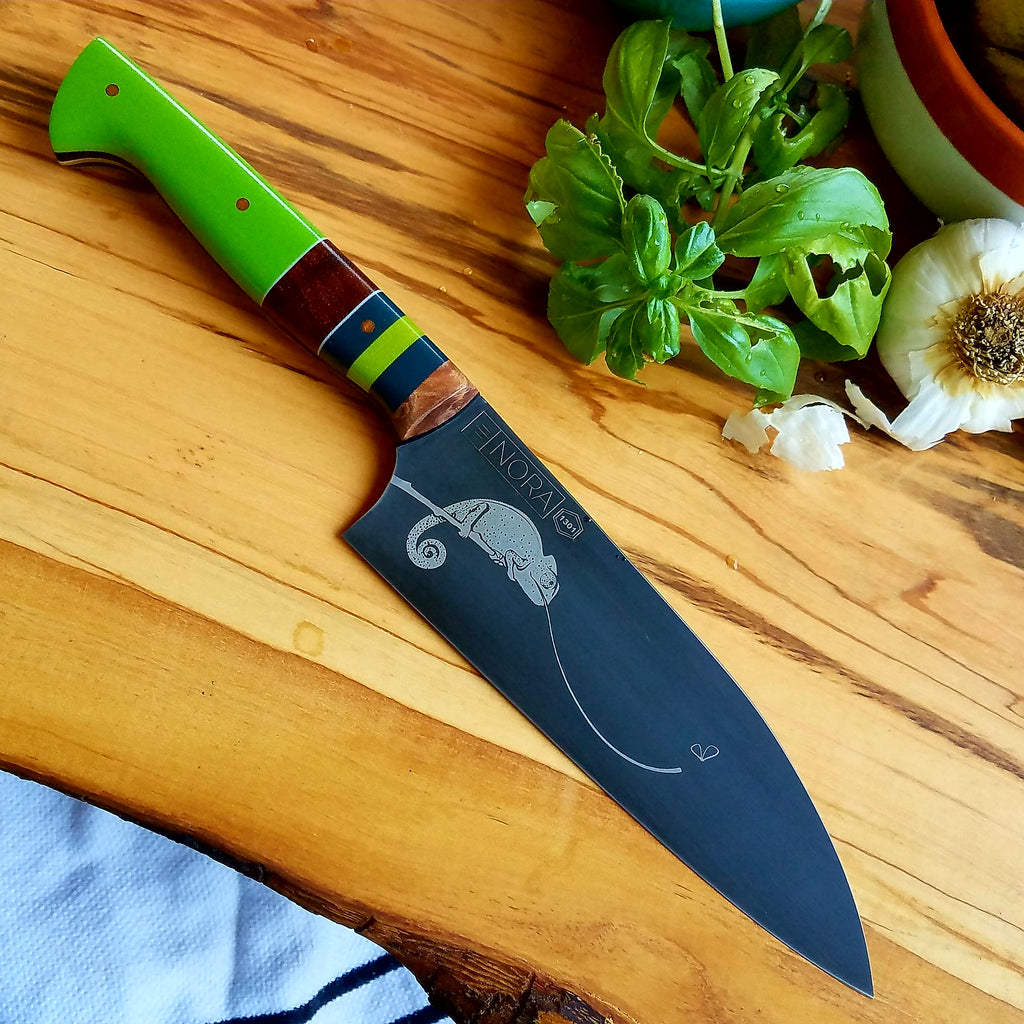
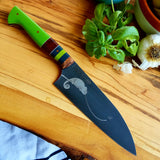
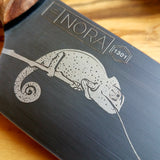
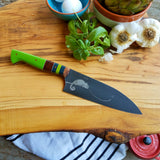
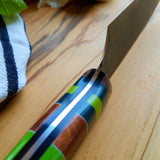
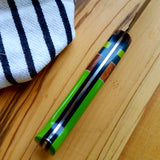
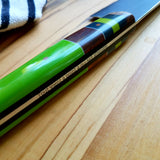
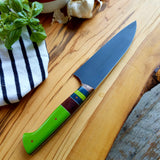
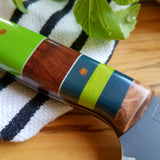
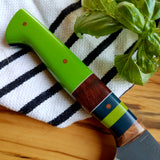
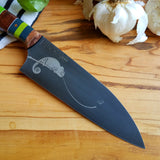
NORA #1301 - CPM M4 Santoku - Karma Chameleon
$ 374.00
KNIFE HIGHLIGHTS
- Blade Type: Santoku
- Blade Length: 6.5 Inches
- Total Length: 11.85 Inches
- Handle Style: Western | Right or Left Hand Use
- Steel: CPM M4 Carbon Steel
- Handle Materials: Lime Green & Forest Green G10, End Grain Bubinga (stabilized), Redwood Burl (stabilized), Gray & Black G10, Natural Micarta Pins
- Rockwell Hardness: 66 HRC
- Grind Type: Workhorse Hybrid Grind (3 different bevels, blended)
- Weight: .50 lbs
- This Blade is Ground...
- Thin for Performance (Best performance but delicate! This knife will cut flawlessly but should not be used on any bones, squash, frozen foods, etc. This one can be considered a "laser" and should be treated with care.)
- Thick for Durability (tough, built to last for heavy wear-n-tear)
- >>> Mid-Range with Special Geometry (specially ground for food release and glide but blade is kept slightly thicker for durability)
- This Knife Feels...
- >>>Heavy in Hand (hefty, durable)
- Light (nimble, maneuverable)
- Not too heavy, not too light (Switzerland)
- This Handle Feels...
- >>>Thick
- Thin
- Mid-Range
GENERAL USES OF THIS KNIFE:
SANTOKU
Our version of a Japanese Santoku, this is an extremely versatile knife that functions similarly to a Chef knife. Santoku literally translates from Japanese as "three virtues" which refers to the three tasks this knife does exceedingly well: slice, dice, and mince. While Santoku knives generally lend themselves towards a chopping motion, we have also designed the blade with just enough belly to facilitate a nice rocking motion as well.
HANDLE DESIGN & MATERIALS:
Every one of our knives is handmade, unique and numbered. This NORA was a fun mix of materials and a play on stripes, which we love. The main base of material is a lime green G10. Many people ask us, what exactly is G10? It is an incredibly strong & durable fiberglass laminate that was originally used in the electronics industry. It has been adapted in the knife making world and has proven to be an excellent material for handles as it has high strength, low moisture absorption and can be found in a variety of colors. Its one of our favorite materials to work with outside of wood. We did in fact though use some wood as well. We added a stripe of end-grain bubinga into the mix as well as a single stripe of redwood burl up top. Its a fun, playful design and should serve you well in the kitchen. To tie in with the vivid green on this one we added a Chameleon to this knife catching the proverbial fly. Chameleon's are odd little creatures to watch. The barely move, the sit, they wait and then all the sudden there is a flash of movement and the work has been done. These little creatures are masters at waiting but then striking when the moment is right. In the same sense we added an engraving that plays upon this idea...
The engraving reads: Tout vient à point à qui sait attendre.
This translates as: All comes on time to the one who knows how to wait.
Little explanation is needed on this one. Its nice to have a reminder that patience is a virtue.
STEEL INFORMATION:
CPM- M4 CARBON STEEL
The blade on this knife is composed of a high carbon CPM M4 steel. M4 is the best carbon steel we have ever used in regards to blade performance. After doing a wide amount of research on this steel, we decided to give it a go and have been extremely impressed with its performance thus far.
CPM M4 steel can be treated to a very high hardness. Hardness in steel generally equates to a finer edge and great edge retention. We took this blade to a solid 66 HRC which is incredibly hard compared to most production knives which fall in the mid to high 50's.
The high hardness allows it to maintain amazing edge retention but unlike other steels at this hardness its not as brittle or delicate. It is actually highly wear resistant which means you don't need to worry as much about the knife chipping or breaking. As an added bonus, M4 is surprisingly corrosion resistant when compared to other carbon steels.
Its a rugged knife for the performance it offers and this combination is rare when you harden steel to beyond 62 HRC. Please note though that the steel isn't bullet-proof...if you drop the knife on a very hard surface or try to muscle it through a very hard object (i.e. hard gourd, thick bones, etc.), it is likely to chip.
The pros of this steel outweigh the cons, but it must be mentioned that this steel is harder to sharpen than many others so you will need to factor that into your decision. It does represent a bit more maintenance than other knives. On the flip side, you don't need to sharpen this knife nearly as frequently as others.
**As this is a carbon steel, the blade will form a slight patina over time. This is normal and is actually the mark of a beautifully used knife. Please note, however, that a carbon knife does require more maintenance than its stainless steel counterpart, mainly that it must be washed or wiped clean shortly after each use to prevent unwanted rust or stains. We have acid etched this knife to protect the steel and start the patina process. Over time this etch will fade slightly and will be replaced by the individual patina you make while using the knife.
CUSTOM ENGRAVING
**This knife has been custom engraved. The engraving was done via laser so there is depth to the engraving more so than you see with an electro etch. We do, however, keep the depth minimal so it does not catch food and minimally interferes with the primary cutting function of the knife. A small amount of stickage is normal around the engraved area, especially initially. This will lessen over time as the blade is used. Please note though, if performance is your #1 priority then we encourage you to NOT purchase this blade. A blade with no engraving WILL have a smoother glide than a blade with engraving. For most, however, this difference is so minimal that it is barely noticed. We just like to provide a full disclosure up front so you know exactly what you are purchasing.
The engraving should last as long as the knife but please note that it will slightly degrade over time as abrasives are used on the knife. We recommend the soft end of a sponge with soap and water for cleaning and mineral oil periodically to condition the blade (and handle). Keep in mind that stronger abrasives, such as steel wool, scotch brite pads, sand paper or stone sharpening directly on the engraved image will further degrade the image.
